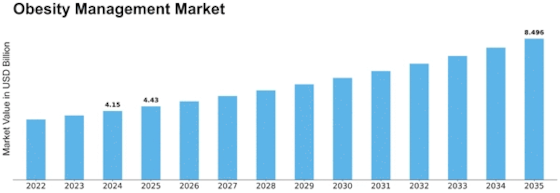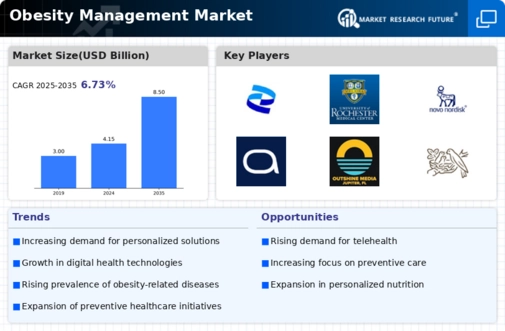Surgical Procedures
Pharmacotherapy
Lifestyle Changes
Fitness Programs
Clinics
Hospitals
Home Care
Fitness Centers
Bariatric Surgery
Pharmaceuticals
Nutritional Counseling
Behavioral Therapy
Online Pharmacies
Retail Pharmacies
Hospitals
Direct Sales
North America
Europe
South America
Asia Pacific
Middle East and Africa
North America Outlook (USD Billion, 2019-2035)
North America Obesity Management Market by Type
Surgical Procedures
Pharmacotherapy
Lifestyle Changes
Fitness Programs
North America Obesity Management Market by End User Type
Clinics
Hospitals
Home Care
Fitness Centers
North America Obesity Management Market by Treatment Method Type
Bariatric Surgery
Pharmaceuticals
Nutritional Counseling
Behavioral Therapy
North America Obesity Management Market by Distribution Channel Type
Online Pharmacies
Retail Pharmacies
Hospitals
Direct Sales
North America Obesity Management Market by Regional Type
US
Canada
US Outlook (USD Billion, 2019-2035)
US Obesity Management Market by Type
Surgical Procedures
Pharmacotherapy
Lifestyle Changes
Fitness Programs
US Obesity Management Market by End User Type
Clinics
Hospitals
Home Care
Fitness Centers
US Obesity Management Market by Treatment Method Type
Bariatric Surgery
Pharmaceuticals
Nutritional Counseling
Behavioral Therapy
US Obesity Management Market by Distribution Channel Type
Online Pharmacies
Retail Pharmacies
Hospitals
Direct Sales
CANADA Outlook (USD Billion, 2019-2035)
CANADA Obesity Management Market by Type
Surgical Procedures
Pharmacotherapy
Lifestyle Changes
Fitness Programs
CANADA Obesity Management Market by End User Type
Clinics
Hospitals
Home Care
Fitness Centers
CANADA Obesity Management Market by Treatment Method Type
Bariatric Surgery
Pharmaceuticals
Nutritional Counseling
Behavioral Therapy
CANADA Obesity Management Market by Distribution Channel Type
Online Pharmacies
Retail Pharmacies
Hospitals
Direct Sales
Europe Outlook (USD Billion, 2019-2035)
Europe Obesity Management Market by Type
Surgical Procedures
Pharmacotherapy
Lifestyle Changes
Fitness Programs
Europe Obesity Management Market by End User Type
Clinics
Hospitals
Home Care
Fitness Centers
Europe Obesity Management Market by Treatment Method Type
Bariatric Surgery
Pharmaceuticals
Nutritional Counseling
Behavioral Therapy
Europe Obesity Management Market by Distribution Channel Type
Online Pharmacies
Retail Pharmacies
Hospitals
Direct Sales
Europe Obesity Management Market by Regional Type
Germany
UK
France
Russia
Italy
Spain
Rest of Europe
GERMANY Outlook (USD Billion, 2019-2035)
GERMANY Obesity Management Market by Type
Surgical Procedures
Pharmacotherapy
Lifestyle Changes
Fitness Programs
GERMANY Obesity Management Market by End User Type
Clinics
Hospitals
Home Care
Fitness Centers
GERMANY Obesity Management Market by Treatment Method Type
Bariatric Surgery
Pharmaceuticals
Nutritional Counseling
Behavioral Therapy
GERMANY Obesity Management Market by Distribution Channel Type
Online Pharmacies
Retail Pharmacies
Hospitals
Direct Sales
UK Outlook (USD Billion, 2019-2035)
UK Obesity Management Market by Type
Surgical Procedures
Pharmacotherapy
Lifestyle Changes
Fitness Programs
UK Obesity Management Market by End User Type
Clinics
Hospitals
Home Care
Fitness Centers
UK Obesity Management Market by Treatment Method Type
Bariatric Surgery
Pharmaceuticals
Nutritional Counseling
Behavioral Therapy
UK Obesity Management Market by Distribution Channel Type
Online Pharmacies
Retail Pharmacies
Hospitals
Direct Sales
FRANCE Outlook (USD Billion, 2019-2035)
FRANCE Obesity Management Market by Type
Surgical Procedures
Pharmacotherapy
Lifestyle Changes
Fitness Programs
FRANCE Obesity Management Market by End User Type
Clinics
Hospitals
Home Care
Fitness Centers
FRANCE Obesity Management Market by Treatment Method Type
Bariatric Surgery
Pharmaceuticals
Nutritional Counseling
Behavioral Therapy
FRANCE Obesity Management Market by Distribution Channel Type
Online Pharmacies
Retail Pharmacies
Hospitals
Direct Sales
RUSSIA Outlook (USD Billion, 2019-2035)
RUSSIA Obesity Management Market by Type
Surgical Procedures
Pharmacotherapy
Lifestyle Changes
Fitness Programs
RUSSIA Obesity Management Market by End User Type
Clinics
Hospitals
Home Care
Fitness Centers
RUSSIA Obesity Management Market by Treatment Method Type
Bariatric Surgery
Pharmaceuticals
Nutritional Counseling
Behavioral Therapy
RUSSIA Obesity Management Market by Distribution Channel Type
Online Pharmacies
Retail Pharmacies
Hospitals
Direct Sales
ITALY Outlook (USD Billion, 2019-2035)
ITALY Obesity Management Market by Type
Surgical Procedures
Pharmacotherapy
Lifestyle Changes
Fitness Programs
ITALY Obesity Management Market by End User Type
Clinics
Hospitals
Home Care
Fitness Centers
ITALY Obesity Management Market by Treatment Method Type
Bariatric Surgery
Pharmaceuticals
Nutritional Counseling
Behavioral Therapy
ITALY Obesity Management Market by Distribution Channel Type
Online Pharmacies
Retail Pharmacies
Hospitals
Direct Sales
SPAIN Outlook (USD Billion, 2019-2035)
SPAIN Obesity Management Market by Type
Surgical Procedures
Pharmacotherapy
Lifestyle Changes
Fitness Programs
SPAIN Obesity Management Market by End User Type
Clinics
Hospitals
Home Care
Fitness Centers
SPAIN Obesity Management Market by Treatment Method Type
Bariatric Surgery
Pharmaceuticals
Nutritional Counseling
Behavioral Therapy
SPAIN Obesity Management Market by Distribution Channel Type
Online Pharmacies
Retail Pharmacies
Hospitals
Direct Sales
REST OF EUROPE Outlook (USD Billion, 2019-2035)
REST OF EUROPE Obesity Management Market by Type
Surgical Procedures
Pharmacotherapy
Lifestyle Changes
Fitness Programs
REST OF EUROPE Obesity Management Market by End User Type
Clinics
Hospitals
Home Care
Fitness Centers
REST OF EUROPE Obesity Management Market by Treatment Method Type
Bariatric Surgery
Pharmaceuticals
Nutritional Counseling
Behavioral Therapy
REST OF EUROPE Obesity Management Market by Distribution Channel Type
Online Pharmacies
Retail Pharmacies
Hospitals
Direct Sales
APAC Outlook (USD Billion, 2019-2035)
APAC Obesity Management Market by Type
Surgical Procedures
Pharmacotherapy
Lifestyle Changes
Fitness Programs
APAC Obesity Management Market by End User Type
Clinics
Hospitals
Home Care
Fitness Centers
APAC Obesity Management Market by Treatment Method Type
Bariatric Surgery
Pharmaceuticals
Nutritional Counseling
Behavioral Therapy
APAC Obesity Management Market by Distribution Channel Type
Online Pharmacies
Retail Pharmacies
Hospitals
Direct Sales
APAC Obesity Management Market by Regional Type
China
India
Japan
South Korea
Malaysia
Thailand
Indonesia
Rest of APAC
CHINA Outlook (USD Billion, 2019-2035)
CHINA Obesity Management Market by Type
Surgical Procedures
Pharmacotherapy
Lifestyle Changes
Fitness Programs
CHINA Obesity Management Market by End User Type
Clinics
Hospitals
Home Care
Fitness Centers
CHINA Obesity Management Market by Treatment Method Type
Bariatric Surgery
Pharmaceuticals
Nutritional Counseling
Behavioral Therapy
CHINA Obesity Management Market by Distribution Channel Type
Online Pharmacies
Retail Pharmacies
Hospitals
Direct Sales
INDIA Outlook (USD Billion, 2019-2035)
INDIA Obesity Management Market by Type
Surgical Procedures
Pharmacotherapy
Lifestyle Changes
Fitness Programs
INDIA Obesity Management Market by End User Type
Clinics
Hospitals
Home Care
Fitness Centers
INDIA Obesity Management Market by Treatment Method Type
Bariatric Surgery
Pharmaceuticals
Nutritional Counseling
Behavioral Therapy
INDIA Obesity Management Market by Distribution Channel Type
Online Pharmacies
Retail Pharmacies
Hospitals
Direct Sales
JAPAN Outlook (USD Billion, 2019-2035)
JAPAN Obesity Management Market by Type
Surgical Procedures
Pharmacotherapy
Lifestyle Changes
Fitness Programs
JAPAN Obesity Management Market by End User Type
Clinics
Hospitals
Home Care
Fitness Centers
JAPAN Obesity Management Market by Treatment Method Type
Bariatric Surgery
Pharmaceuticals
Nutritional Counseling
Behavioral Therapy
JAPAN Obesity Management Market by Distribution Channel Type
Online Pharmacies
Retail Pharmacies
Hospitals
Direct Sales
SOUTH KOREA Outlook (USD Billion, 2019-2035)
SOUTH KOREA Obesity Management Market by Type
Surgical Procedures
Pharmacotherapy
Lifestyle Changes
Fitness Programs
SOUTH KOREA Obesity Management Market by End User Type
Clinics
Hospitals
Home Care
Fitness Centers
SOUTH KOREA Obesity Management Market by Treatment Method Type
Bariatric Surgery
Pharmaceuticals
Nutritional Counseling
Behavioral Therapy
SOUTH KOREA Obesity Management Market by Distribution Channel Type
Online Pharmacies
Retail Pharmacies
Hospitals
Direct Sales
MALAYSIA Outlook (USD Billion, 2019-2035)
MALAYSIA Obesity Management Market by Type
Surgical Procedures
Pharmacotherapy
Lifestyle Changes
Fitness Programs
MALAYSIA Obesity Management Market by End User Type
Clinics
Hospitals
Home Care
Fitness Centers
MALAYSIA Obesity Management Market by Treatment Method Type
Bariatric Surgery
Pharmaceuticals
Nutritional Counseling
Behavioral Therapy
MALAYSIA Obesity Management Market by Distribution Channel Type
Online Pharmacies
Retail Pharmacies
Hospitals
Direct Sales
THAILAND Outlook (USD Billion, 2019-2035)
THAILAND Obesity Management Market by Type
Surgical Procedures
Pharmacotherapy
Lifestyle Changes
Fitness Programs
THAILAND Obesity Management Market by End User Type
Clinics
Hospitals
Home Care
Fitness Centers
THAILAND Obesity Management Market by Treatment Method Type
Bariatric Surgery
Pharmaceuticals
Nutritional Counseling
Behavioral Therapy
THAILAND Obesity Management Market by Distribution Channel Type
Online Pharmacies
Retail Pharmacies
Hospitals
Direct Sales
INDONESIA Outlook (USD Billion, 2019-2035)
INDONESIA Obesity Management Market by Type
Surgical Procedures
Pharmacotherapy
Lifestyle Changes
Fitness Programs
INDONESIA Obesity Management Market by End User Type
Clinics
Hospitals
Home Care
Fitness Centers
INDONESIA Obesity Management Market by Treatment Method Type
Bariatric Surgery
Pharmaceuticals
Nutritional Counseling
Behavioral Therapy
INDONESIA Obesity Management Market by Distribution Channel Type
Online Pharmacies
Retail Pharmacies
Hospitals
Direct Sales
REST OF APAC Outlook (USD Billion, 2019-2035)
REST OF APAC Obesity Management Market by Type
Surgical Procedures
Pharmacotherapy
Lifestyle Changes
Fitness Programs
REST OF APAC Obesity Management Market by End User Type
Clinics
Hospitals
Home Care
Fitness Centers
REST OF APAC Obesity Management Market by Treatment Method Type
Bariatric Surgery
Pharmaceuticals
Nutritional Counseling
Behavioral Therapy
REST OF APAC Obesity Management Market by Distribution Channel Type
Online Pharmacies
Retail Pharmacies
Hospitals
Direct Sales
South America Outlook (USD Billion, 2019-2035)
South America Obesity Management Market by Type
Surgical Procedures
Pharmacotherapy
Lifestyle Changes
Fitness Programs
South America Obesity Management Market by End User Type
Clinics
Hospitals
Home Care
Fitness Centers
South America Obesity Management Market by Treatment Method Type
Bariatric Surgery
Pharmaceuticals
Nutritional Counseling
Behavioral Therapy
South America Obesity Management Market by Distribution Channel Type
Online Pharmacies
Retail Pharmacies
Hospitals
Direct Sales
South America Obesity Management Market by Regional Type
Brazil
Mexico
Argentina
Rest of South America
BRAZIL Outlook (USD Billion, 2019-2035)
BRAZIL Obesity Management Market by Type
Surgical Procedures
Pharmacotherapy
Lifestyle Changes
Fitness Programs
BRAZIL Obesity Management Market by End User Type
Clinics
Hospitals
Home Care
Fitness Centers
BRAZIL Obesity Management Market by Treatment Method Type
Bariatric Surgery
Pharmaceuticals
Nutritional Counseling
Behavioral Therapy
BRAZIL Obesity Management Market by Distribution Channel Type
Online Pharmacies
Retail Pharmacies
Hospitals
Direct Sales
MEXICO Outlook (USD Billion, 2019-2035)
MEXICO Obesity Management Market by Type
Surgical Procedures
Pharmacotherapy
Lifestyle Changes
Fitness Programs
MEXICO Obesity Management Market by End User Type
Clinics
Hospitals
Home Care
Fitness Centers
MEXICO Obesity Management Market by Treatment Method Type
Bariatric Surgery
Pharmaceuticals
Nutritional Counseling
Behavioral Therapy
MEXICO Obesity Management Market by Distribution Channel Type
Online Pharmacies
Retail Pharmacies
Hospitals
Direct Sales
ARGENTINA Outlook (USD Billion, 2019-2035)
ARGENTINA Obesity Management Market by Type
Surgical Procedures
Pharmacotherapy
Lifestyle Changes
Fitness Programs
ARGENTINA Obesity Management Market by End User Type
Clinics
Hospitals
Home Care
Fitness Centers
ARGENTINA Obesity Management Market by Treatment Method Type
Bariatric Surgery
Pharmaceuticals
Nutritional Counseling
Behavioral Therapy
ARGENTINA Obesity Management Market by Distribution Channel Type
Online Pharmacies
Retail Pharmacies
Hospitals
Direct Sales
REST OF SOUTH AMERICA Outlook (USD Billion, 2019-2035)
REST OF SOUTH AMERICA Obesity Management Market by Type
Surgical Procedures
Pharmacotherapy
Lifestyle Changes
Fitness Programs
REST OF SOUTH AMERICA Obesity Management Market by End User Type
Clinics
Hospitals
Home Care
Fitness Centers
REST OF SOUTH AMERICA Obesity Management Market by Treatment Method Type
Bariatric Surgery
Pharmaceuticals
Nutritional Counseling
Behavioral Therapy
REST OF SOUTH AMERICA Obesity Management Market by Distribution Channel Type
Online Pharmacies
Retail Pharmacies
Hospitals
Direct Sales
MEA Outlook (USD Billion, 2019-2035)
MEA Obesity Management Market by Type
Surgical Procedures
Pharmacotherapy
Lifestyle Changes
Fitness Programs
MEA Obesity Management Market by End User Type
Clinics
Hospitals
Home Care
Fitness Centers
MEA Obesity Management Market by Treatment Method Type
Bariatric Surgery
Pharmaceuticals
Nutritional Counseling
Behavioral Therapy
MEA Obesity Management Market by Distribution Channel Type
Online Pharmacies
Retail Pharmacies
Hospitals
Direct Sales
MEA Obesity Management Market by Regional Type
GCC Countries
South Africa
Rest of MEA
GCC COUNTRIES Outlook (USD Billion, 2019-2035)
GCC COUNTRIES Obesity Management Market by Type
Surgical Procedures
Pharmacotherapy
Lifestyle Changes
Fitness Programs
GCC COUNTRIES Obesity Management Market by End User Type
Clinics
Hospitals
Home Care
Fitness Centers
GCC COUNTRIES Obesity Management Market by Treatment Method Type
Bariatric Surgery
Pharmaceuticals
Nutritional Counseling
Behavioral Therapy
GCC COUNTRIES Obesity Management Market by Distribution Channel Type
Online Pharmacies
Retail Pharmacies
Hospitals
Direct Sales
SOUTH AFRICA Outlook (USD Billion, 2019-2035)
SOUTH AFRICA Obesity Management Market by Type
Surgical Procedures
Pharmacotherapy
Lifestyle Changes
Fitness Programs
SOUTH AFRICA Obesity Management Market by End User Type
Clinics
Hospitals
Home Care
Fitness Centers
SOUTH AFRICA Obesity Management Market by Treatment Method Type
Bariatric Surgery
Pharmaceuticals
Nutritional Counseling
Behavioral Therapy
SOUTH AFRICA Obesity Management Market by Distribution Channel Type
Online Pharmacies
Retail Pharmacies
Hospitals
Direct Sales
REST OF MEA Outlook (USD Billion, 2019-2035)
REST OF MEA Obesity Management Market by Type
Surgical Procedures
Pharmacotherapy
Lifestyle Changes
Fitness Programs
REST OF MEA Obesity Management Market by End User Type
Clinics
Hospitals
Home Care
Fitness Centers
REST OF MEA Obesity Management Market by Treatment Method Type
Bariatric Surgery
Pharmaceuticals
Nutritional Counseling
Behavioral Therapy
REST OF MEA Obesity Management Market by Distribution Channel Type
Online Pharmacies
Retail Pharmacies
Hospitals
Direct Sales


















Leave a Comment